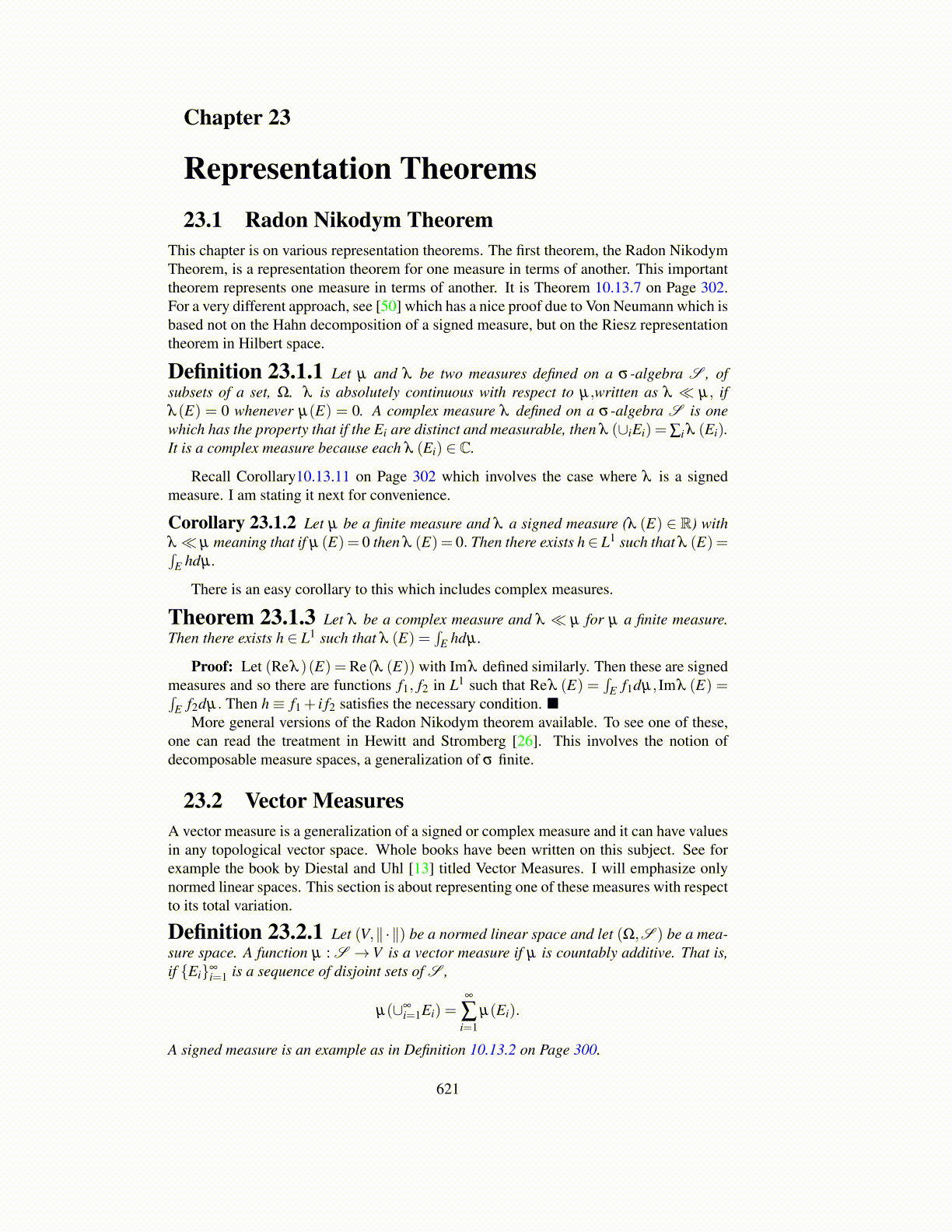
Chapter 23
Representation Theorems23.1 Radon Nikodym Theorem
This chapter is on various representation theorems. The first theorem, the Radon NikodymTheorem, is a representation theorem for one measure in terms of another. This importanttheorem represents one measure in terms of another. It is Theorem 10.13.7 on Page 302.For a very different approach, see [50] which has a nice proof due to Von Neumann which isbased not on the Hahn decomposition of a signed measure, but on the Riesz representationtheorem in Hilbert space.
Definition 23.1.1 Let µ and λ be two measures defined on a σ -algebra S , ofsubsets of a set, Ω. λ is absolutely continuous with respect to µ,written as λ ≪ µ, ifλ (E) = 0 whenever µ(E) = 0. A complex measure λ defined on a σ -algebra S is onewhich has the property that if the Ei are distinct and measurable, then λ (∪iEi) = ∑i λ (Ei).It is a complex measure because each λ (Ei) ∈ C.
Recall Corollary10.13.11 on Page 302 which involves the case where λ is a signedmeasure. I am stating it next for convenience.
Corollary 23.1.2 Let µ be a finite measure and λ a signed measure (λ (E) ∈ R) withλ ≪ µ meaning that if µ (E) = 0 then λ (E) = 0. Then there exists h∈ L1 such that λ (E) =∫
E hdµ .
There is an easy corollary to this which includes complex measures.
Theorem 23.1.3 Let λ be a complex measure and λ ≪ µ for µ a finite measure.Then there exists h ∈ L1 such that λ (E) =
∫E hdµ .
Proof: Let (Reλ )(E) = Re(λ (E)) with Imλ defined similarly. Then these are signedmeasures and so there are functions f1, f2 in L1 such that Reλ (E) =
∫E f1dµ, Imλ (E) =∫
E f2dµ. Then h≡ f1 + i f2 satisfies the necessary condition. ■More general versions of the Radon Nikodym theorem available. To see one of these,
one can read the treatment in Hewitt and Stromberg [26]. This involves the notion ofdecomposable measure spaces, a generalization of σ finite.
23.2 Vector MeasuresA vector measure is a generalization of a signed or complex measure and it can have valuesin any topological vector space. Whole books have been written on this subject. See forexample the book by Diestal and Uhl [13] titled Vector Measures. I will emphasize onlynormed linear spaces. This section is about representing one of these measures with respectto its total variation.
Definition 23.2.1 Let (V,∥ · ∥) be a normed linear space and let (Ω,S ) be a mea-sure space. A function µ : S → V is a vector measure if µ is countably additive. That is,if {Ei}∞
i=1 is a sequence of disjoint sets of S ,
µ(∪∞i=1Ei) =
∞
∑i=1
µ(Ei).
A signed measure is an example as in Definition 10.13.2 on Page 300.
621